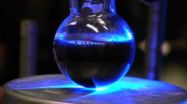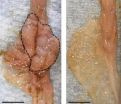(Press-News.org) A UCLA-led team of researchers has found evidence that photosensitizing a virus's membrane covering can inhibit its ability to enter cells and potentially lead to the development of stronger, cheaper medications to fight a host of tough viruses.
The UCLA AIDS Institute study, published in the February issue of the Journal of Virology, is part of ongoing research on a compound called LJ001, a "broad-spectrum" antiviral that can attack a wide range of microbes.
The current paper advances the science by showing that the process of photosensitization — heightening a biological organism's sensitivity to certain damaging processes induced by light — applies to more than just LJ001. This could pave the way for a cost-effective way to make blood products safer, which is particularly important in resource-poor countries where deadly viruses run rampant.
There are two categories of viruses: lipid-enveloped and non-enveloped. Enveloped viruses, including many that are of great public health concern, have a membrane that serves as a mechanism through which the microbe inserts its genome into a host cell, infecting it.
Photosensitizers, which have the ability to damage a virus's genetic material, can in many cases prevent infection, according to first author Frederic Vigant, who conducted the study as a postdoctoral researcher in microbiology, immunology and molecular genetics at the David Geffen School of Medicine at UCLA.
"The ability of photosensitizers to inactivate many different viruses has been known for decades," Vigant said, pointing out their well-known ability to cross-link the DNA and RNA of lipid-enveloped viruses, causing irreversible damage. "It must have seemed so obvious this
was how photosensitizers work that no one ever looked in detail at the oxidation of the lipids. Oxidation of lipids by light — termed photo-oxidation — is also very well known."
For the current study, an international research team led by Dr. Benhur Lee, adjunct professor of microbiology, immunology and molecular genetics at the Geffen School, nailed down how photo-oxidation of the viral lipid envelope can be a general method for compromising the ability of such viruses to enter cells.
In an earlier proof-of-principle study published in 2010, the researchers described an antiviral small molecule — a rhodanine derivative they dubbed LJ001 — that is effective against numerous viruses, including HIV-1, influenza A, filoviruses, poxviruses, arenaviruses, bunyaviruses, paramyxoviruses and flaviviruses. These viruses cause some of the world's deadliest diseases, such as AIDS, Nipah virus encephalitis, Ebola hemorrhagic fever and Rift Valley fever. This LJ001 compound could also be effective against new, yet-to-be discovered enveloped viruses, the researchers said.
In a subsequent paper published in April 2013 in PLOS Pathogens, the team found that the LJ001 broad-spectrum antiviral, and its more potent second-generation derivatives, could affect not just some but any lipid-enveloped virus via photosensitization of the envelope. It was the first time this process was identified and used as an antiviral strategy, Lee said.
The new Journal of Virology paper, Lee said, shows that this new paradigm for antivirals applies to more than just LJ001. The team examined another broad-spectrum antiviral compound called dUY11, which had been thought to act as a "wedge" by inserting itself into viral membranes and compacting the lipids, impairing fusion and entry into cells. The new research demonstrates that the process is unlikely to happen on its own because it is inactive in the dark. It turned out to behave as a photosensitizer in all the experiments they performed.
As with LJ001 and its derivatives, dUY11 enters the viral membranes, is activated by light and then changes the lipid composition of the viral coating, resulting in the inability of the virus to fuse with and enter cells.
"In other words, instead of the compound itself acting as a physical constraint on the membrane, we show that it actually works through photochemical reactions that end up changing the biophysical properties of the virus membrane that make it unable to mediate fusion," Vigant said.
INFORMATION:
Jihye Lee and Michael E. Jung of UCLA and Axel Hollmann and Nuno C. Santos of the Universidade de Lisboa co-authored the paper.
Vigant and Lee are now with the Icahn School of Medicine at Mount Sinai.
Grants from the National Institutes of Health (U01 AI070495, U01 AI082100, R01 AI069317, U54 AI065359) and from the Fundação para a Ciência e a Tecnologia–Ministério
da Educação e Ciência (Portugal) project (VIH/SAU/0047/2011 and fellowship SFRH/BPD/72037/2010) supported this work.
The UCLA AIDS Institute and Center for AIDS Research is a multidisciplinary group of top-flight researchers united in the worldwide fight against HIV/AIDS, the first cases of which were reported in 1981 by UCLA physicians. Institute members include researchers in virology and immunology, genetics, cancer, neurology, ophthalmology, epidemiology, social science, public health, nursing and disease prevention. Their findings have led to advances in preventing and treating HIV, as well as other diseases, such as hepatitis B and C, influenza, tuberculosis and cancer. To find out about ways to support these efforts, please contact Laura Pescatore at lpescatore@support.ucla.edu.
For more news, visit the UCLA Newsroom and follow us on Twitter.
Light zaps viruses: How photosensitization can stop viruses from infecting cells
2014-03-04
ELSE PRESS RELEASES FROM THIS DATE:
A highly sensitive small molecule probe to evaluate potential risk for Parkinson's disease
2014-03-04
A team of researchers from National University of Singapore (NUS) have created the first two-photon, small molecule fluorogenic probe that can serve as a useful tool for the rapid assessment of an individual's potential risk for Parkinson's disease. The highly sensitive fluorescence probe can detect with high precision the activity of Monoamine Oxidase B (MAO-B), an enzyme that is found in elevated levels in patients with Parkinson's disease. This innovation paves the way for the development of less costly non-invasive technologies and devices to help monitor the risk and ...
Immune system-based therapy produces lasting remissions in melanoma patients
2014-03-04
BOSTON – A drug that unleashes the immune system to attack cancer can produce lasting remissions and hold the disease in check – for more than two years, in some cases – in many patients with advanced melanoma, according to a new study by researchers at Dana-Farber Cancer Institute, Johns Hopkins University, Yale University, and allied institutions.
The study, published online today, March 3, by the Journal of Clinical Oncology, provides the longest-term look so far at how melanoma patients have fared since receiving the drug, nivolumab, in a phase I clinical trial. The ...
Every step you take
2014-03-04
Artificial photosynthesis, in which we emulate the process used by nature to capture energy from the sun and convert it into electrochemical energy, is expected to be a major asset in any sustainable energy portfolio for the future. Artificial photosynthesis offers the promise of producing liquid fuels that are renewable and can be used without exacerbating global climate change. A key to realizing commercial-scale artificial photosynthesis technology is the development of electrocatalysts that can efficiently and economically carry out water oxidation reaction that is ...
Eliminating bacteria, changing lifestyle could lower risk in people genetically susceptible to color
2014-03-04
New York, NY— Bacteria in the gut are essential for the development of intestinal tumors in mice, according to research led by investigators from the Icahn School of Medicine at Mount Sinai. Removing the bacteria may play a critical role in reducing cancer risk, the researchers write, in the March issue of the Journal of Experimental Medicine.
Sergio A. Lira, MD, PhD, Director of the Immunology Institute, and Professor of Immunology and Medicine, and his laboratory at the Icahn School of Medicine at Mount Sinai, used a transgenic mouse model to test the hypothesis that ...
Voters using smartphones made fewer errors in mock election
2014-03-04
Voters who cast their ballots via smartphones made fewer errors than they did when voting via traditional methods in a mock election, according to new research from psychologists at Rice University.
In a first-of-its-kind study, co-author Rice Professor of Psychology Michael Byrne examined how smartphone-based voting systems can be incorporated into the current large-scale voting process. The study, "Toward More Usable Electronic Voting: Testing the Usability of a Smartphone Voting System," found that while there are no consistent differences in efficiency and perceived ...
Native American city on the Mississippi was America's first 'melting pot'
2014-03-04
CHAMPAIGN, Ill. — New evidence establishes for the first time that Cahokia, a sprawling, pre-Columbian city situated at the confluence of the Missouri and Mississippi rivers, hosted a sizable population of immigrants.
Cahokia was an early experiment in urban life, said Thomas Emerson, who led the new analysis. Emerson is Illinois state archaeologist and the director of the Illinois State Archaeological Survey at the University of Illinois.
Researchers have traditionally thought of Cahokia as a relatively homogeneous and stable population drawn from the immediate area, ...
Researchers discover how soils control atmospheric hydrogen
2014-03-04
Researchers at New Zealand's University of Otago are helping to clear up an enduring mystery regarding the composition of the Earth's atmosphere. They have discovered the microbial soil processes that help ensure that the explosive gas hydrogen remains at trace levels.
In recent decades it was found that around four-fifths of all hydrogen released into the air is rapidly removed through soil activity, but exactly what is recycling it, and how, has remained unclear.
Now, Otago scientists have shown that the soil bacterium Mycobacterium smegmatis uses two special enzymes ...
Increased intake of fish can boost good cholesterol levels
2014-03-04
Increasing the intake of fatty fish increases the number of large HDL particles, according to a recent study completed at the University of Eastern Finland. People who increased their intake of fish to a minimum of 3–4 weekly meals had more large HDL particles in their blood than people who are less frequent eaters of fish. Large HDL particles are believed to protect against cardiovascular diseases. The results were published in PLOS ONE.
The consumption of fish has long been know to be beneficial for health; however, the mechanisms by which fats and other useful nutrients ...
Liver metabolism study could help patients awaiting transplants
2014-03-04
In a new study that could help doctors extend the lives of patients awaiting liver transplants, a Rice University-led team of researchers examined the metabolic breakdown that takes place in liver cells during late-stage cirrhosis and found clues that suggest new treatments to delay liver failure.
More than 17,000 Americans are awaiting a liver transplant, and of those, about 1,500 will die this year while still waiting, according to the American Liver Foundation. The new research, which appeared online Feb. 27 in the Journal of Hepatology, suggests new treatments that ...
Homing in on cancer with a comprehensive measurement method
2014-03-04
Cancer is the second most common cause of death in Switzerland. There are many reasons why in the era of cutting-edge medicine it is still difficult to cure this disease. A tumour may, for instance, consist of different tumour cell subpopulations, each of which has its own profile and responds differ-ently to therapy – or not. Furthermore, the cancer cells and the healthy cells in the body interact and communicate with one another. How a tumour then actually develops and whether metastases form depends on which signals a tumour cell receives from its environment. With the ...


